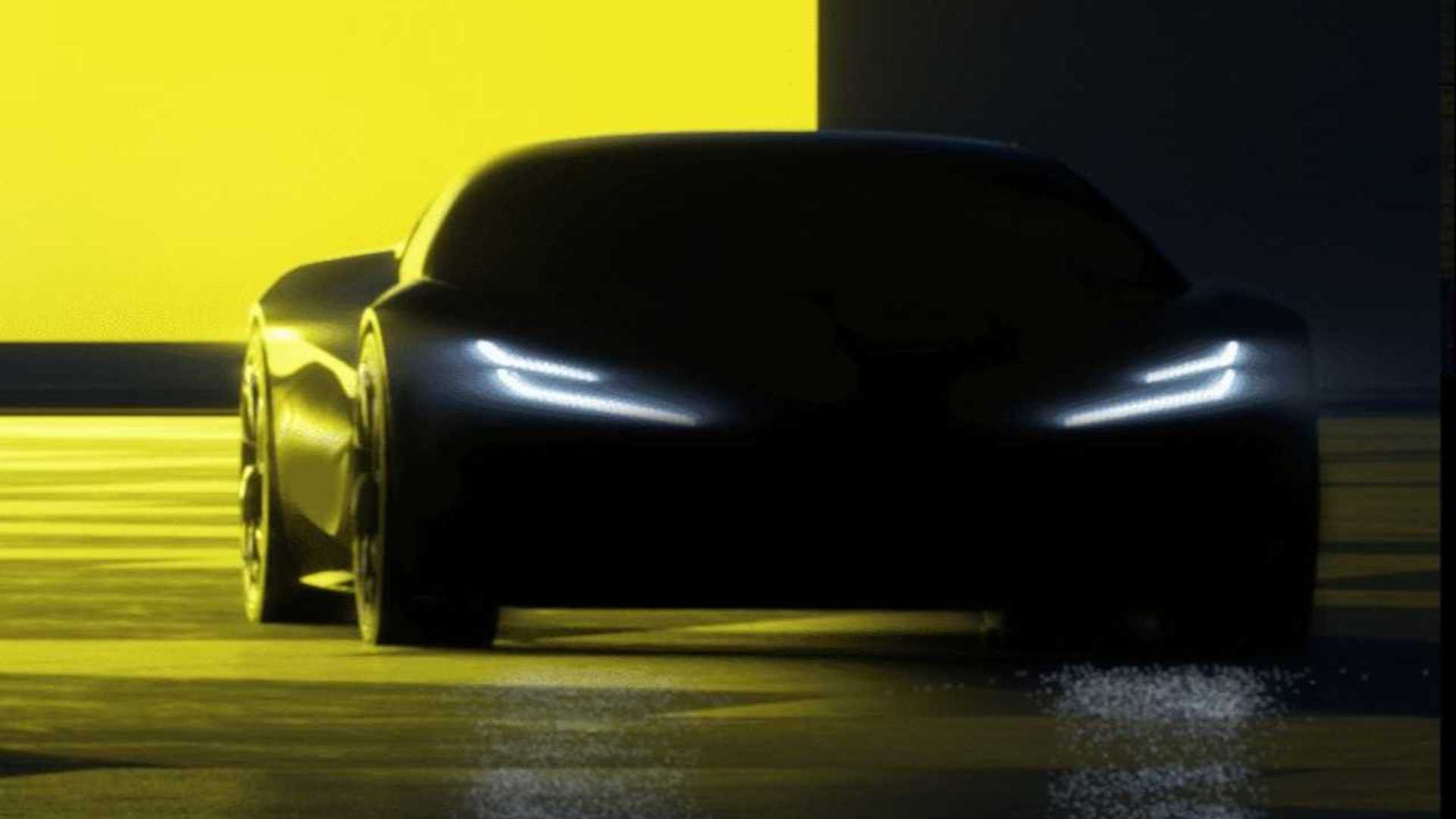There’s more to the future of Lotus than big electric SUVs. That’s what the British company once famous for its lightweight sports cars wants you to believe—and it’s why Lotus has revealed a striking new supercar concept, called Theory 1.
To be clear, this is not an electric rebirth of the Lotus Esprit, the wedge-shaped '70s icon driven into the sea by James Bond. At least not yet. Lotus aficionados will notice its name isn’t “Type” followed by three numbers, as is concept car tradition, nor does it begin with an E, as almost all production Lotuses do. Instead, it’s a way of showcasing technology that Lotus has planned for future cars and, just maybe, a hint of a supercar to come.
Speaking exclusively to WIRED, Lotus design vice president Ben Payne said: “We wanted to recapture that sense of purity, but not to do a kind of pastiche of an Esprit, because that doesn’t make any sense. So it’s more about the spirit of that car, the logic of the design and how controlled it is in the execution.”
That sense of control is key to all aspects of the Theory 1. Lotus could have given it 2,000 horsepower to match its Evija flagship, but it settled at a more reasonable 987 hp (1,000 PS). It could have let its designers run wild with enormous aero structures, ground-effect fans, and other hypercar paraphernalia, or overdosed on concept car tropes like huge touchscreen displays, artificial intelligence, or a drone that takes off from the rear deck.
Instead, Lotus did what it is best known for and, in the apocryphal words of founder Colin Chapman, it “simplified, then added lightness.”
Payne explained: “There’s been this period of maximalism, and people having to do one-upmanship and go above, above, above. And I think we’ve reached that point where it plateaus in stylistic terms, and also in the demonstration of tech.” He adds, “We’re not in a crazy numbers race with this car.”
Although not crazy by 2024 EV standards, Lotus is still pitching the Theory 1 as a seriously quick supercar. It’s aiming for a range of 250 miles from a modest 70-kWh battery, an all-wheel-drive system with its rear motor bolted directly to the suspension, motorsport-style, a 0 to 62-mph time of under 2.5 seconds, and a top speed of 200 mph. That’s all the usual supercar boxes ticked, but it’s nothing to give Rimac sleepless nights—or indeed get awkwardly close to Lotus’ own $2.3 million Evija.
More important than outright power is weight. Lotus says the all-carbon Theory 1 has a target of sub-1,600 kg (3,500 lbs), or around 300 kg less than the Evija. To further drive the weight-saving point home, the car has just 10 “A-surface materials”—those being the materials you can see and touch without digging beneath the surface—compared to the industry average of 100, according to Lotus. The 10 include cellulose-based glass fiber, chopped carbon fiber, and titanium, as well as recycled forms of glazing, polyester, rubber, and aluminum.
It’s also sensibly sized, as far as modern supercars go, with a width of 2,000 mm (78.7 inches), a length of 4,490 mm (176.8 inches), and a height of 1,140 mm (44.9 inches). Add this relative sensibility to the ingeniously practical doors, three seats, and excellent visibility, and it’s easy to imagine what a production version could look like.
A Sci-Fi Interior
For now this is a concept that ties together key technologies: advanced laser lighting, recycled materials, 3D printing, binaural audio, and a new form of robotized haptic control in place of touchscreens, to name a few—and presents them in a way that feels believable.
You could also say Theory 1 is a message of hope for Lotus fans dismayed by a company that killed off its critically acclaimed Elise, Exige, and Evora sports cars in one fell swoop, and now produces a pair of “lifestyle” EVs in the Eletre SUV and Emeya sedan. Lotus wants to remind us that it still knows how to build sports cars, it still majors in driver involvement, and it’ll continue to do so when internal combustion engines are no more.
Open the doors, which cleverly lift upwards then slide backwards to create a huge opening while taking up very little space, and the emptiness of the cabin is a shock. The driver sits in the center, flanked by two passengers, and all three occupants sit directly on the carbon tub. It looks like a race car from an alien planet, but once you’re seated and the adjustable steering wheel and pedals are brought toward you, it’s perfectly comfortable.
In fact, the seating position is close to other Lotus cars, and, despite how the interior looks, the driver won’t feel like they’ve been dropped into the uncompromising, intimidating cockpit of a Formula One car. Payne told WIRED: “That’s a key driver to the project—let’s not make it super extreme. We don’t want these cars to scare people.”
A head-up display is projected onto a black panel at the foot of the windshield, putting key information such as speed and navigation commands right in the driver’s eyeline. Digital screens acting as wing mirrors sit inboard of the A pillars; light signals are reflected off the windshield in the driver’s peripheral vision; suspension components sprout from where the dashboard of a conventional car would be; and the flat-top, flat-bottom steering wheel houses another digital display.
Despite the obvious visual drama on show, the interior’s biggest feature is not what the driver sees, but what they feel. Embedded in the fabric of the doors, steering wheel, and sculpted seats are dozens of inflatable pods, each individually controlled. Using a technology called fluidics, they work in a similar way to massage seats, but are much smaller and therefore deliver a quicker, more precise sensation. They can be used to send haptic feedback to the driver through their seat, or for creating physical buttons that rise from interior surfaces only when they are needed.
Developed by a Berlin company called MotorSkins, the technology was created for exoskeleton-style clothing intended to help with disabilities linked to muscle weakness. But for the Lotus Theory 1 it has been adapted to perform as a so-called reactive textile, where interior surfaces physically change based on how the car is being driven and what the driver needs.
Facundo Gutierrez, managing director of MotorSkins, explained to WIRED how “the technology is only there when you need it, and then it disappears, like buttons on demand. For example, you are driving and there is a car coming up behind you. [The seat fabric] can give you a gentle tap on the shoulder. Or you get a phone call, and the button appears for you to take the call.”
Such tactility also means switchgear can be controlled by touch instead of swiping or tapping at a display. Dismissing the car industry’s current obsession with touchscreens, Payne adds: “Part of a driver’s car has got to be more about muscle memory and physical things that you don’t have to look at.”
A Futuristic Sound System
Lotus Theory 1 also showcases a sound system integrated into its three headrests. The speakers—two per occupant, plus a subwoofer behind the driver—are from audio specialist KEF and are mounted in a 3D-printed lattice structure from Carbon, an additive manufacturing specialist in California. An alternative to foam, the lattice is made from a polyurethane elastomer called EPU 46, which has previously been used for shoes and bicycle saddles.
The headrest is made from a single material, but by changing how the lattice shape is printed, it can have multiple compression resistances. This means one component produced from one material can supposedly be made for both comfort and crash protection, lowering the complexity of both production and recycling. Toby Simon, cofounder and CEO of Carbon, told WIRED: “What’s cool about printing it is how you can control what areas have different types of performance … The material is the same throughout the part, but 3D printing allows us to change the geometry in different regions.”
Although shown here on a concept car, Simon says the Carbon lattice has already been tested and flame-rated to automotive interior standards, and “can absolutely be used at mass scale.”
The Theory 1’s KEF sound system fires binaural audio directly at each occupant, in a bid to create their own 3D sound experience. Binaural sound usually only works with headphones, since that prevents the speakers from interfering with each other. But in this instance KEF believes it can use the lattice headrests to its advantage.
Speaking to WIRED, KEF’s head of acoustics, George Perkins, explained: “The concept here is to use the soft lattice structure to measure the head position, to identify precisely and yet unobtrusively where the head position is. Then you can have, in theory, perfect binaural rendering.”
This scenario relies on the driver and passengers to be always touching the headrests. Perkins continues: “The idea is that the [3D-printed lattice] structure is made from a smart material, like a graphene rubber. So as the material bends or flexes, electrical signals are created and transmitted in the nanoscale graphene, and then this is used to interpret the head position. It’s a direct sense of the head position created by the deforming of the structure.”
Lotus hasn’t revealed what the Theory 1 might sound like, but KEF says it can not only produce futuristic sound effects to compliment the car’s performance, but also use a subwoofer to create other sensations. Perkins said: “You need powerful subwoofers [to create a physical experience similar to that of an engine], but you don’t necessarily need uncontrolled vibration. So we actually use a force-canceling subwoofer that doesn’t generate spurious vibration of the cabin, but can generate very, very powerful bass and high pressure inside the cabin to give a sense of power.”
A New Chapter for Lotus?
It’s easy to stir up a debate by asking what sports car and supercar companies will do to win sales when their characterful engines are outlawed, replaced by soulless batteries and motors. It’s a question some, like Aston Martin, Bentley and McLaren, prefer to kick down the road. Ferrari, which to its credit plans to reveal its first EV in 2025, will surely mourn the passing of the V12 engine like the death of Enzo himself.
But Lotus sees things differently. Payne told WIRED: “Moving into the age of electrification and intelligence, some [experience] a sentiment of loss and of losing something. And there is, I guess, something that’s moving away. But, you know, Lotus is quite a strange company. It’s always been almost drivetrain agnostic. What is the iconic Lotus engine? We don’t really have it. It was always about the technology to fulfill a certain goal.
“Enzo [Ferrari] said about paying for the engine of his cars and the rest being free. That wasn’t Lotus. What you pay for is the chassis, dynamic capability, innovation, and the amazing connection that you have. The engine was never really the talking point. So I think it makes sense for us, on a brand level, to go into electrification.”
The Theory 1's futuristic tech, innovative design and focus on driving experience suggest that Lotus is not just looking to keep up with the electric revolution, but to lead it. The Theory 1 is a statement of intent, a promise that the iconic British brand is not just a relic of the past, but a pioneer of the future.

















